Many thanks to SWLing Post contributor, Rick Slobodian, who seeks help solving a 22 year old mystery. Rick writes:
[Perhaps you can help me] explain this antenna….a 22 year old mystery antenna (see photo above)? What sort of antenna is this and how does it work? It’s at 49.8994 N 24.685 E near Krasne, Ukraine.
I was at this transmitter site in 1998.
I was writing articles for a number of magazines hoping to find customers for airtime and to make this site viable.
I spent all day at the site wrote extensively about EVERYTHING ELSE: the shortwave transmitters, the longwave transmitters, the shortwave antennas, the vertical long wave antennas, and the vertical MW antennas.
The transmitters were behemoths: Komintern Burans 500Kw 1000 Kw 1200 Kw
This antenna was over a km form the main building and they would let me go there:
Its 36 towers strung in a NE SE line–over 2 km long and each tower is approximately 40 m tall.
[My hosts] were they so evasive about this antenna array yet not the rest of the site.
[There are some peculiarities:]
- Do you see a feed line running along the bottom of the towers near the ground?
- I do not see any tuning shacks.
- Is it fed from one end or the other end or is each tower fed?
- If each tower is fed, then where are the tuning shacks/phasors?
- iIf it is a beverage then why so may towers and such close spacing?
- Is it something completely different?
What do you think it is? How do you think it works and what would be its purpose?
Thanks for sharing, Rick! My hope is that one of the members of the Post community may be able to shed a little light on this interesting antenna array. Please comment!

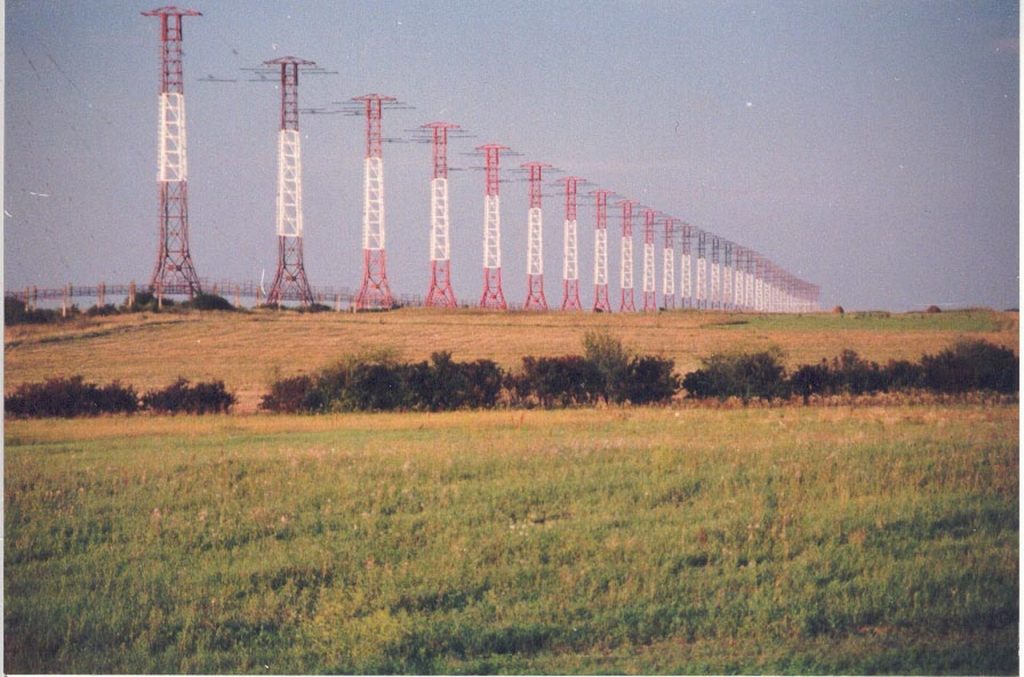
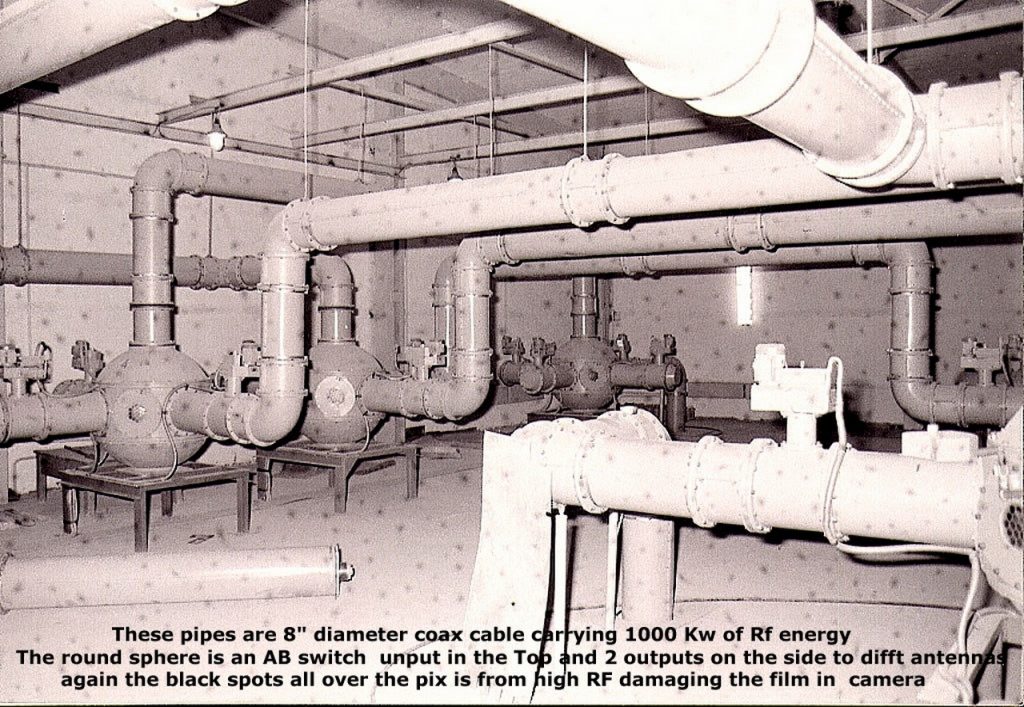
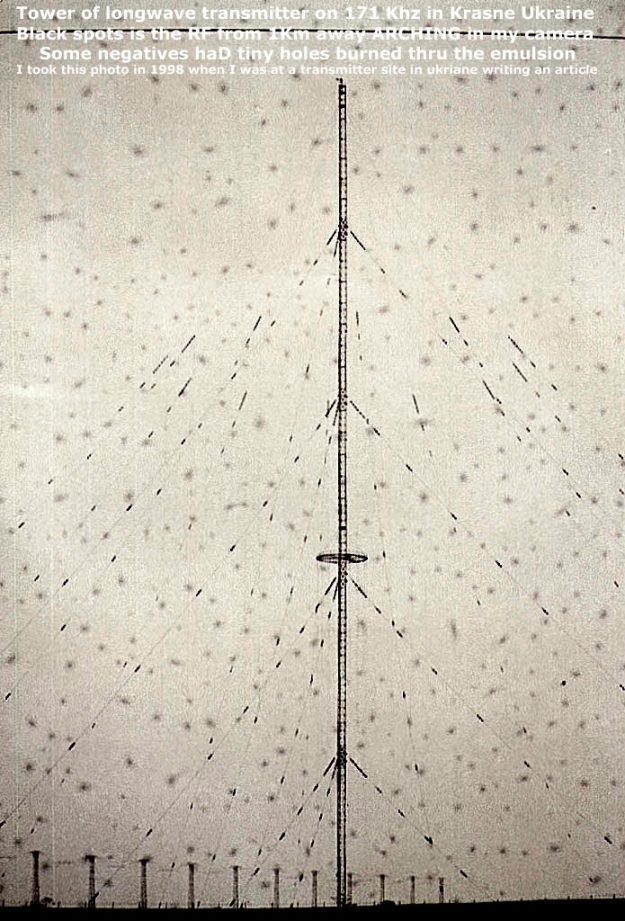
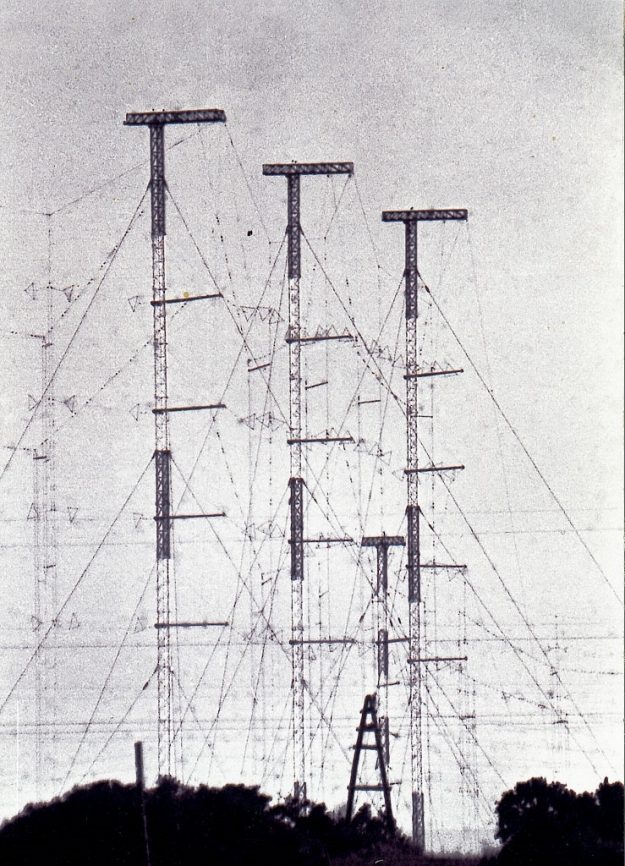
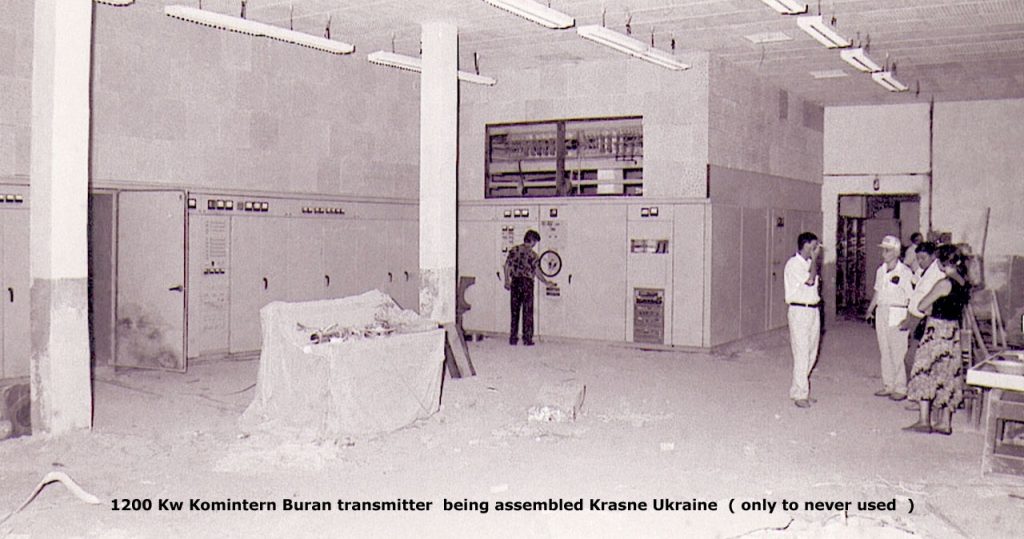
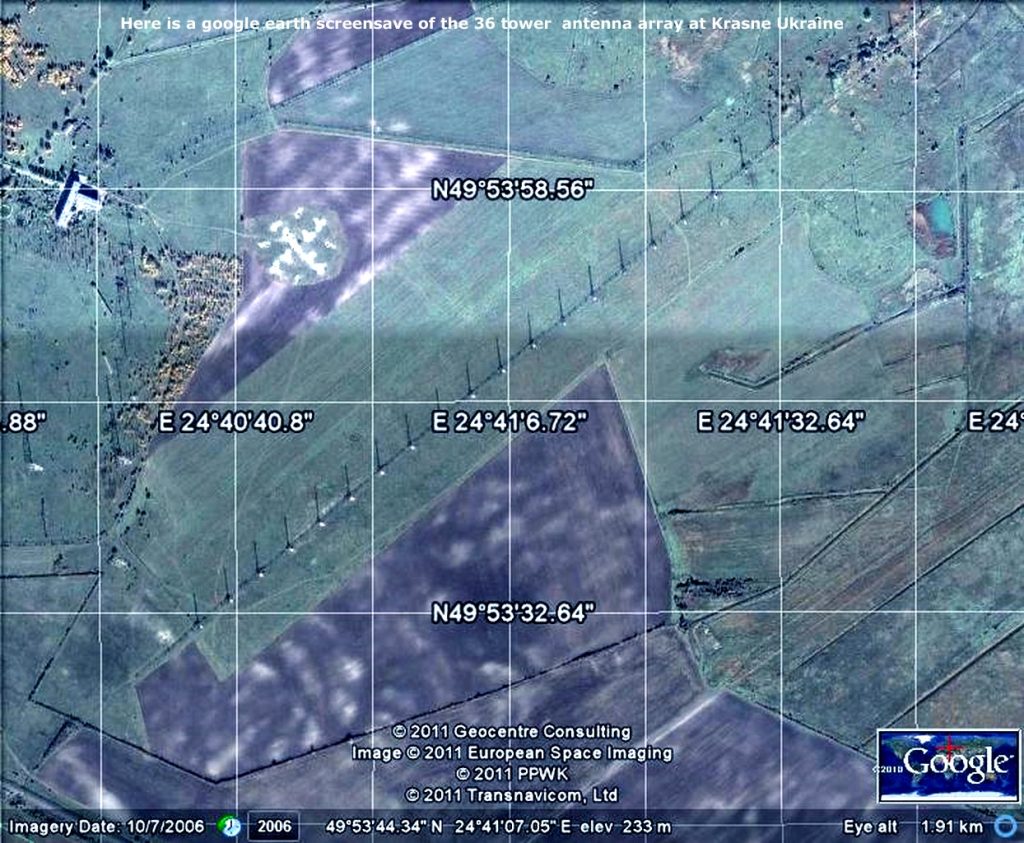
Does not look like a beam to broadside at 330°, but like an endfire beam at 240°. So could be to broadcast towards Algeria and North-West Africa.
Wow, we got a real mystery here! When I first saw the picture I thought, “It looks just like those ionosphere radars.” Couldn’t remember the name for some reason, but easy enough to find: it looks superficially like a SuperDARN array: https://en.wikipedia.org/wiki/Super_Dual_Auroral_Radar_Network
However, these radars don’t operate (on individual antennae) anywhere close to megawatt levels even though the array as a whole might: systems like HAARP, PAVE PAWS, and others are obvious examples.
The photos don’t look like VLF systems but there are a lot more of these in Europe than here in western hemisphere: only the single stick with the holes in the film (never seen that before!) looks like systems over here like Lualualei and LaMoure (the old OMEGA stations with tuned guys that are part of the antenna system), while systems like Cutler and (I think) Annapolis are based on the German now Russian Goliath (monster umbrellas).
If it is a variant on the very old design still used in Grimeton, then they must be using a lot of down links, perhaps even using the towers (Grimeton uses separate down leads that are hard to photograph while the towers are grounded). I’d love to know what this actually is!
FWIW, there’s nothing “top secret” about VLF transmitters other than the encrypted messages: trying to “hide” them is like trying to hide an aircraft carrier or a city: It’s impossible!
a dug roam
Its likely some type of HAARP array
Would a modern digital camera work in this type of environment? Electronics get fried not even turned on?
Yes but you get wave lines across the sensor. You can see this effect in live action by looking up videos of CB radio “Key Down” contests. Film is fine in these environments it was just the camera he used, as u can see he mentioned in 1 description arcing of the camera body. Also doubtful it happened at 1km. Since when he was as the transmitter site it would’ve Swiss cheesed the whole film roll at once not just whatever frame was exposed.
It is type of medium wave transmitting antenna named “Sredyaya Zarya” or “Bolshoya Zarya” (Medium or Big Dawn). It is directional antenna for high-power skywave broadcasting at night. It gives possibility to broadcast in one of two possibly directions. Lots of post USSR high power AM transmitting radio-center contains that type of antenna (for ex. Sasnovy in Belarus on 1170 kHz) .
Photos of similar antennas in other TX site in Russia:
https://farm2.staticflickr.com/1894/30281193798_e79da3c6e3_b.jpg
https://farm2.staticflickr.com/1831/44099861272_f72123ab50_b.jpg
https://farm2.staticflickr.com/1860/42339454430_745bf67105_b.jpg
Antenna in Krasne probably transmitted on medium wave Radio Ukraine after Cold War and Radio Mayak in Cold War.
I think you have it – the antennas appear to be exactly the same as the ones at Krasne.
That’s definitely it. Given the odd secrecy stuff the poster mentioned more than likely weird government stuff though. Wonder if it’s to be used slightly lower in longwave for submarine comms or something like that.
Possibly a Russian over the horizon H.F. radar…we called it the Wood Pecker, skipping around on H.F. , here in the us…it used frequency hopping techniques..
There are a few additional pictures of the array at wikimapia;
http://wikimapia.org/6046299/Former-HF-MW-LW-Tuner-radio-center
These show more clearly spreader bars between the towers but there are no element wires below the spreaders, only horizontal wires between the spreaders so they’re not conventional curtain antennas. OTH radar arrays are very different and comprise many more elements. My guess would be a VLF array, it looks similar to the Grimeton array in Sweden which was 1.2 miles long. The feeder looks like an open wire construction (probably balanced) and if it’s a VLF antenna only a single feed would be required.
If it was VLF than those top wires wouldn’t be the antenna but the capacitance top load with a vertical active radiating wire element hanging somewhere in there.
Whatever it was, it was (or still is) very likely military and probably top secret and there’s plenty of room for speculation but it’s unlikely that anything could ever be confirmed or verified. Maybe it’s not complete anymore (or maybe it was never completed), maybe the feed lines are underground (the picture you posted has something near the ground that does look like a feedline running somewhere), maybe there’s more underground facilities, so deriving the purpose from the looks of it on distance and satellite shots is pretty hopeless.
Almost 2km of length could point to “something VLF”, but indeed, the very short distance (~60m?) between the towers and the location doesn’t seem to make sense for this purpose. A 2km wide array of whatever was strung up between the pretty short towers doesn’t necessarily indicate “OTHR”, could be, maybe not, after all there’s already the unnumbered Duga test site in Mykolaiv and of course the Duga-1 near Chernobyl in the country, so maybe it’s just one of the infamous huge “radio protection” jamming sites.
Here’s a website that calls the installation “Big Dawn”, but I think that was a designator for a Siberian jamming site, who knows…
http://wikimapia.org/33654432/The-antenna-system-Big-Dawn
An SWL visited that region and calls it the “Bolshoye Zorya” antenna, but again, I think that name belonged to a different installation:
http://www.dxing.info/articles/renewed_interest_dxing.dx
Is that related to the “DUGA” radar system (also known as the “Russian Woodpeeker”) ?
https://en.wikipedia.org/wiki/Duga_radar
Wow, the field strength is so high that it reduces the silver halide in film back to metallic silver! I wonder how many of the technicians ended up with cancer!
Types of HF broadcast antennas https://www.itu.int/en/ITU-R/terrestrial/broadcast/HFBC/Documents/antcode.pdf shows that the most likely type is the curtain array. No tuning hut is required because the dipoles are long enough to be half wavelength.
It looks like a huge or multiple curtain arrays https://www.bbceng.info/Technical%20Reviews/HF%20Curtain%20Arrays%20-%20final.pdf. It is a bit hard to see from the photos of the HF arrays.
It’s OTHR [over the horizon radar] (the tx site). Elsewhere, not too far away will be the rx site. Current day OTHR is active from another site near Moscow. Both can be seen on Google Maps/Earth. For the site you give there is a single still photo, but it shows the long wave and OTHR towers are still intact. The satellite shot shows the antenna field is seemingly complete. In the case of the newer OTHR a road passes nearby for which there is a complete StreetView ‘pass’. The current one has been DF’ed by IARU Region 1 interference monitors to that location and is the source of large signals in bands 7-14 MHz.
More information. The main array consists of 27 towers over a baseline of 1950 m. That reveals an exact spacing of 75 m. The main (full) beam axis is aimed at 330 degrees, which places the maximum landing ‘spot’ at Butte Montana. I don’t know, but that whole area may correspond to the greater concentration of ICBMs in CONUS, which makes sense.
You can only imagine the reaction to the spy satellite shots when this thing was being built!
That strongly implies it was part of one of the Woodpeckers. “THE” Russian Woodpecker AKA NATO “Steel Yard” was DUGA 3 who’s transmitter was located in Chernobyl and is well within the Exclusion Zone these days, with photos all over the place: the photos presented in this article are clearly not DUGA 3 which looks like a beefy but otherwise “normal looking” curtain array you’d see on any other SW broadcast station from the 50’s to 80’s or so when the French ALISS systems started to appear & were so successful the Chinese immediately copied them.
Remember that on all OTHRs the TX & RX must be separated by a long distance to avoid self-desense (T/R switches used on higher frequency radars obviously don’t provide enough isolation, as proven by the photos above!) Apparently they can apply some tricks to reduce this distance in the most recent generation but it still needs some.